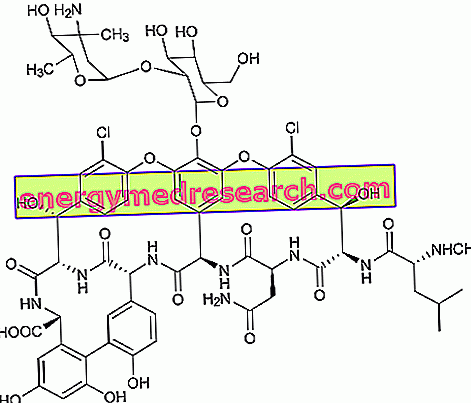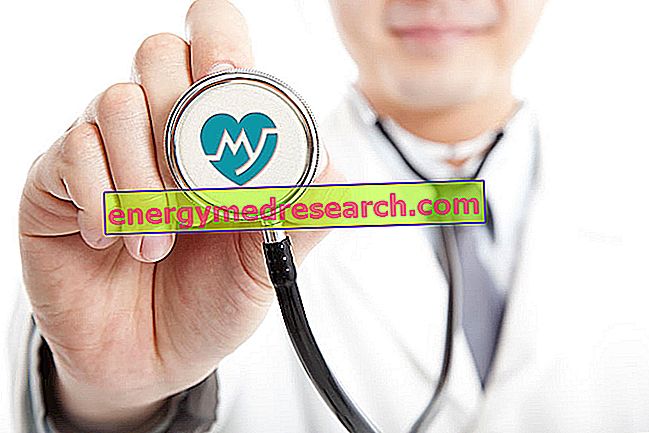Vancomycin is a cyclic peptide with antibiotic action, obtained by fermentation of the bacterium Amicolatopsis orientalis . It has a spectrum of action restricted to Gram-positive bacteria and is particularly useful against multi-resistant ones.
Vancomycin is marketed in pharmaceutical formulations suitable for oral administration and intravenous infusion.

Vancomycin - Chemical Structure
Indications
For what it uses
The use of vancomycin is indicated in the treatment of:
- Pseudomembranous colitis caused by Clostridium difficile and which developed as a result of antibiotic therapy (vancomycin, however, should only be administered orally, otherwise it is not effective);
- Severe staphylococcal infections from methicillin-resistant bacterial strains;
- Infections caused by bacteria resistant to other antibiotics but sensitive to vancomycin;
- Infections in patients allergic to penicillins and cephalosporins.
In addition, vancomycin can be used to prevent bacterial endocarditis during surgical procedures.
Warnings
Before starting treatment with vancomycin, you must inform your doctor if you are in any of the following conditions:
- If you are suffering from kidney disease;
- If you have a low blood count;
- If you are suffering from deafness or other ear problems;
- If you are pregnant or breastfeeding;
- If you are over 60 years of age;
- If you have to undergo surgery;
- In case patients are premature babies.
In the event of any allergic reaction to vancomycin, treatment with the drug should be stopped immediately.
When vancomycin is administered by too rapid infusion, hypotension and rash may occur. These symptoms usually cease when the infusion stops.
Vancomycin should be used with caution in patients suffering from kidney disease or taking nephrotoxic drugs, as there is an increased risk of developing kidney toxicity.
Regular checks of renal function should be performed for the duration of vancomycin treatment.
Patients with pre-existing deafness - when treated with vancomycin at high doses or with vancomycin in combination with other ototoxic medicinal products - may develop temporary or permanent deafness.
Regular blood tests should be performed during treatment with vancomycin, especially if for long periods.
Vancomycin could promote superinfections with resistant bacteria or fungi normally found in human bacterial flora.
Vancomycin may alter the ability to drive or use machines, so caution should be used.
Interactions
Concomitant administration of vancomycin and other ototoxic and / or nephrotoxic drugs should be avoided. These drugs include:
- aminoglycosides;
- Amphotericin B;
- Cisplatin;
- colistin;
- Bacitracin.
Following the concomitant administration of vancomycin and anesthetic drugs, the onset of skin rashes, istamino-like redness and anaphylaxis has been reported.
Side effects
Vancomycin can induce various types of side effects, although not all patients experience them. This depends on the different sensitivity that each person has towards the drug. Therefore, it is said that the adverse effects do not occur all with the same intensity in each individual.
The main side effects that can occur during vancomycin therapy are listed below.
Blood and lymphatic system disorders
Treatment with vancomycin can cause disorders of the blood and lymphatic system (ie the system used to produce blood cells). Such disturbances can cause:
- Pancytopenia, that is the abnormal decrease of all blood cells;
- Eosinophilia, ie an increase in the blood concentration of eosinophils.
- Anemia;
- Plateletopenia (ie the decrease in the number of platelets in the bloodstream), with a consequent increase in the risk of bleeding;
- Leukopenia, ie the reduction in the number of leukocytes in the bloodstream.
Allergic reactions
Vancomycin can trigger allergic reactions in sensitive individuals. These reactions can occur with symptoms such as:
- Drug fever;
- Nausea;
- Chills;
- eosinophilia;
- Hypotension;
- Wheezing breath;
- Urticaria;
- Itch;
- Stevens-Johnson syndrome;
- Exfoliative dermatitis;
- Dyspnoea;
- Anaphylaxis;
- Vasculitis (rare cases).
Gastrointestinal disorders
Vancomycin therapy can cause nausea and - only if taken intravenously - pseudomembranous colitis.
Cardiovascular disorders
Treatment with vancomycin may cause:
- Flushing;
- Hypotension;
- Shock;
- Cardiac arrest.
Hepatobiliary disorders
Vancomycin therapy may increase blood levels of liver transaminases, hepatitis and jaundice.
Kidney and urinary tract disorders
Treatment with vancomycin may alter renal function tests. In addition, the drug can cause kidney failure and interstitial nephritis.
Skin and subcutaneous tissue disorders
Vancomycin therapy may promote the onset of:
- Exfoliative dermatitis;
- Bullous dermatitis;
- Rash;
- Itch;
- Urticaria;
- Toxic epidermal necrolysis;
- Stevens-Johnson syndrome;
- vasculitis;
- Anaphylactic syndrome with erythematous eruption.
Ear and labyrinth disorders
Treatment with vancomycin can cause dizziness, tinnitus and hearing loss.
Infusion-dependent side effects
During or after a rapid infusion of vancomycin may occur:
- Erythematous rash on the trunk, neck and sometimes on the face that may be accompanied by itching, hives, dyspnea and wheezing (red neck syndrome);
- Hypotensive syndrome;
- Spastic pain syndrome, ie a syndrome characterized by acute and pulsating pains and spasms of the thoracic or paraspinal musculature;
- phlebitis;
- thrombophlebitis;
- Inflammation at the injection site.
Overdose
If you suspect a vancomycin overdose, you must immediately inform your doctor or go to the nearest hospital.
Action mechanism
Vancomycin exerts its antibiotic action by inhibiting the synthesis of the bacterial cell wall, ie it inhibits the synthesis of peptidoglycan.
Peptidoglycan is a polymer made up of parallel chains of nitrogenated carbohydrates, joined together by transverse bonds between amino acid residues.
Vancomycin acts by inhibiting the activity of two fundamental enzymes involved in the biosynthesis of the aforementioned wall: transglycosylase and transpeptidase.
By inhibiting the synthesis of peptidoglycan, the bacteria undergo cell lysis and die.
Mode of Use - Posology
Vancomycin is available for oral administration in the form of capsules or powder for oral solution and for intravenous administration in the form of a powder that must be dissolved in a suitable solvent just before its use.
The dose of vancomycin administered and the duration of treatment must be established by the doctor, depending on the type and severity of the infection to be treated and on the age and clinical condition of each patient.
Following are some indications on the doses of vancomycin usually administered.
Regardless of the route of administration chosen, in elderly patients and / or in patients suffering from renal diseases, the doctor may decide to administer lower doses of vancomycin than those usually used.
Oral administration
In adults, the dose of vancomycin usually used varies from 500 mg to 2 g of drug, to be administered in two or four divided doses.
In children, the recommended vancomycin dose is 40 mg / kg body weight per day, to be taken in divided doses. The maximum daily dose of 2 g of drug should never be exceeded.
Intravenous administration
In adults and children over the age of 12, the amount of drug usually used is 2 g, to be administered in two or four divided doses.
In children under 12 years of age, the dose of vancomycin usually administered is 10 mg / kg of body weight per day every 6-12 hours.
Pregnancy and breastfeeding
The use of vancomycin by pregnant women should only be done if the doctor thinks it is a case of real need.
Since vancomycin is excreted in breast milk, breastfeeding mothers must seek advice from their doctor before taking the drug, who will decide whether or not to stop breastfeeding.
Contraindications
The use of vancomycin is contraindicated in patients with known hypersensitivity to vancomycin itself.



